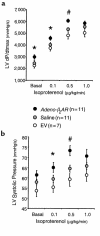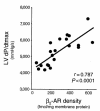Enhancement of cardiac function after adenoviral-mediated in vivo intracoronary beta2-adrenergic receptor gene delivery
- PMID: 10393695
- PMCID: PMC408402
- DOI: 10.1172/JCI6026
Enhancement of cardiac function after adenoviral-mediated in vivo intracoronary beta2-adrenergic receptor gene delivery
Abstract
Exogenous gene delivery to alter the function of the heart is a potential novel therapeutic strategy for treatment of cardiovascular diseases such as heart failure (HF). Before gene therapy approaches to alter cardiac function can be realized, efficient and reproducible in vivo gene techniques must be established to efficiently transfer transgenes globally to the myocardium. We have been testing the hypothesis that genetic manipulation of the myocardial beta-adrenergic receptor (beta-AR) system, which is impaired in HF, can enhance cardiac function. We have delivered adenoviral transgenes, including the human beta2-AR (Adeno-beta2AR), to the myocardium of rabbits using an intracoronary approach. Catheter-mediated Adeno-beta2AR delivery produced diffuse multichamber myocardial expression, peaking 1 week after gene transfer. A total of 5 x 10(11) viral particles of Adeno-beta2AR reproducibly produced 5- to 10-fold beta-AR overexpression in the heart, which, at 7 and 21 days after delivery, resulted in increased in vivo hemodynamic function compared with control rabbits that received an empty adenovirus. Several physiological parameters, including dP/dtmax as a measure of contractility, were significantly enhanced basally and showed increased responsiveness to the beta-agonist isoproterenol. Our results demonstrate that global myocardial in vivo gene delivery is possible and that genetic manipulation of beta-AR density can result in enhanced cardiac performance. Thus, replacement of lost receptors seen in HF may represent novel inotropic therapy.
Figures







Similar articles
-
Intracoronary adenovirus-mediated delivery and overexpression of the beta(2)-adrenergic receptor in the heart : prospects for molecular ventricular assistance.Circulation. 2000 Feb 1;101(4):408-14. doi: 10.1161/01.cir.101.4.408. Circulation. 2000. PMID: 10653833
-
Potentiation of beta-adrenergic signaling by adenoviral-mediated gene transfer in adult rabbit ventricular myocytes.J Clin Invest. 1997 Jan 15;99(2):288-96. doi: 10.1172/JCI119157. J Clin Invest. 1997. PMID: 9005997 Free PMC article.
-
Adenovirus-mediated gene transfer of the beta2-adrenergic receptor to donor hearts enhances cardiac function.Gene Ther. 1999 Jul;6(7):1298-304. doi: 10.1038/sj.gt.3300940. Gene Ther. 1999. PMID: 10455439
-
Genetic manipulation of myocardial beta-adrenergic receptor activation and desensitization.J Mol Cell Cardiol. 2004 Jul;37(1):11-21. doi: 10.1016/j.yjmcc.2004.03.014. J Mol Cell Cardiol. 2004. PMID: 15242731 Review.
-
Gene delivery approaches to heart failure treatment.Expert Opin Biol Ther. 2004 Sep;4(9):1413-22. doi: 10.1517/14712598.4.9.1413. Expert Opin Biol Ther. 2004. PMID: 15335309 Review.
Cited by
-
Reverse cardiac remodeling enabled by mechanical unloading of the left ventricle.J Cardiovasc Transl Res. 2009 Mar;2(1):114-25. doi: 10.1007/s12265-008-9057-6. Epub 2008 Sep 30. J Cardiovasc Transl Res. 2009. PMID: 20559975 Review.
-
Gene therapy for heart failure: where do we stand?Curr Cardiol Rep. 2013 Feb;15(2):333. doi: 10.1007/s11886-012-0333-3. Curr Cardiol Rep. 2013. PMID: 23307169 Free PMC article. Review.
-
Targeting calcium cycling proteins in heart failure through gene transfer.J Physiol. 2003 Jan 1;546(Pt 1):49-61. doi: 10.1113/jphysiol.2002.026732. J Physiol. 2003. PMID: 12509478 Free PMC article. Review.
-
Defining the success of cardiac gene therapy: how can nuclear imaging contribute?Eur J Nucl Med Mol Imaging. 2003 May;30(5):757-71. doi: 10.1007/s00259-002-1100-2. Epub 2003 Jan 23. Eur J Nucl Med Mol Imaging. 2003. PMID: 12541135 Review.
-
Future g protein-coupled receptor targets for treatment of heart failure.Curr Treat Options Cardiovasc Med. 2009 Aug;11(4):328-38. doi: 10.1007/s11936-009-0033-5. Curr Treat Options Cardiovasc Med. 2009. PMID: 19627665
References
-
- Cohn JN, et al. Report of the National Heart, Lung, and Blood Institute Special Emphasis Panel on Heart Failure Research. Circulation. 1997;95:766–770. - PubMed
-
- Brodde OE. Beta-adrenoceptors in cardiac disease. Pharmacol Ther. 1993;60:405–430. - PubMed
-
- Bristow MR, et al. Decreased catecholamine sensitivity and β-adrenergic receptor density in failing human hearts. N Engl J Med. 1982;307:205–211. - PubMed
-
- Ping P, Anzai T, Gao M, Hammond HK. Adenylyl cyclase and G protein receptor kinase expression during development of heart failure. Am J Physiol. 1997;273:H707–H717. - PubMed
Publication types
MeSH terms
Substances
Grants and funding
LinkOut - more resources
Full Text Sources
Other Literature Sources
Medical
Research Materials
Miscellaneous

